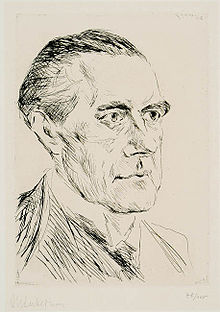Peter Behrens
| Peter Behrens | |
|---|---|

Portrait of Peter Behrens by Max Liebermann
|
|
| Born | 14 April 1868 Hamburg |
| Died | 27 February 1940 (aged 71) Berlin |
| Nationality | German |
| Occupation | Architect |
| Buildings | AEG Turbine Factory |
| Projects | Deutscher Werkbund |
Peter Behrens (14 April 1868 – 27 February 1940) was a German architect and designer. He was important for the modernist movement, and several of the movement's leading names (including Ludwig Mies van der Rohe, Le Corbusier and Walter Gropius) worked for him in earlier stages of their careers.
Behrens attended the Christianeum Hamburg from September 1877 until Easter 1882. He studied painting in his native Hamburg, as well as in Düsseldorf and Karlsruhe, from 1886 to 1889. In 1890, he married Lilly Kramer and moved to Munich. At first, he worked as a painter, illustrator and book-binder in a sort of artisanal way. He frequented the bohemian circles and was interested in subjects related to the reform of life-styles. In 1899 Behrens accepted the invitation of the Grand-duke Ernst-Ludwig of Hesse to be the second member of his recently inaugurated Darmstadt Artists' Colony, where Behrens built his own house and fully conceived everything inside the house (furniture, towels, paintings, pottery, etc.) The building of this house is considered to be the turning point in his life, when he left the artistic circles of Munich and moved away from the Jugendstil towards a sober and austere style of design.
He was one of the leaders of architectural reform at the turn of the century and was a major designer of factories and office buildings in brick, steel and glass. In 1903, Behrens was named director of the Kunstgewerbeschule in Düsseldorf, where he implemented successful reforms. In 1907, Behrens and ten other people (Hermann Muthesius, Theodor Fischer, Josef Hoffmann, Joseph Maria Olbrich, Bruno Paul, Richard Riemerschmid, Fritz Schumacher, among others), plus twelve companies, gathered to create the German Werkbund. As an organization, it was clearly indebted to the principles and priorities of the Arts and Crafts movement, but with a decidedly modern twist. Members of the Werkbund were focused on improving the overall level of taste in Germany by improving the design of everyday objects and products. This very practical aspect made it an extremely influential organization among industrialists, public policy experts, designers, investors, critics and academics. Behrens' work for AEG was the first large-scale demonstration of the viability and vitality of the Werkbund's initiatives and objectives.
...
Wikipedia
